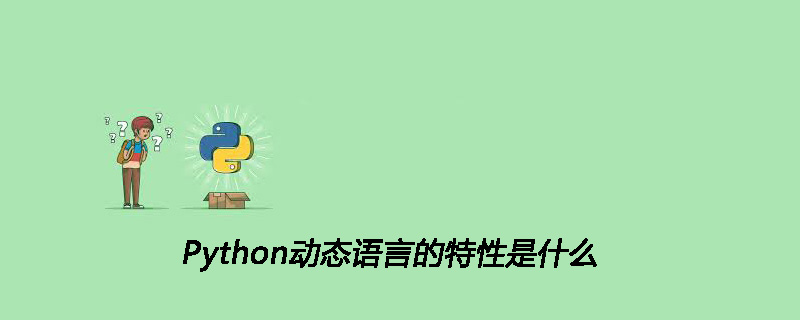
一、动态语言的定义
动态语言是在运行时确定数据类型的语言。变量使用之前不需要类型声明,通常变量的类型是被赋值的那个值的类型。现在比较热门的动态语言有:Python、PHP、JavaScript、Objective-C等,而 C 、 C++ 等语言则不属于动态语言。
二、运行的过程中给对象绑定(添加)属性
class Person(object):
def __init__(self,name=None,age=None):
self.name=name
self.age=age
p = Person("ipipgo","24")
print(p.name)
print(p.age)
运行结果为:
ipipgo 24
这里我们只定义了name和age两个属性,但是在类已经定义好了之后,我们仍然可以往里面添加属性,这就是动态语言的好处,动态的给实例绑定属性:
class Person(object):
def __init__(self,name=None,age=None):
self.name=name
self.age=age
p = Person("ipipgo","24")
print(p.name)
print(p.age)
#动态添加属性
p.sex = "男"
print(p.sex)
运行结果为:
ipipgo 24 男
三、运行的过程中给类绑定(添加)属性
class Person(object):
def __init__(self,name=None,age=None):
self.name=name
self.age=age
P1 = Person("ipipgo",24)
print(P1.sex)
运行结果为:
Traceback (most recent call last): File "C:\Users\Se7eN_HOU\Desktop\test.py", line 8, in <module> print(P1.sex) AttributeError: 'Person' object has no attribute 'sex'
这是程序报错说,Person没有sex这个属性,我们可以通过给Person动态绑定属性,解决问题。
class Person(object):
def __init__(self,name=None,age=None):
self.name=name
self.age=age
P1 = Person("ipipgo",24)
#动态给类添加属性
Person.sex = "男"
print(P1.sex)
这个时候在运行就不会出错,而且会打印出P1.sex为男。
四、运行的过程中给类绑定(添加)方法
class Person(object):
def __init__(self,name=None,age=None):
self.name=name
self.age=age
def eat(self):
print("正在吃东西")
P1 = Person("ipipgo",24)
P1.eat()
P1.run()
运行结果为:
正在吃东西 Traceback (most recent call last): File "C:\Users\Se7eN_HOU\Desktop\test.py", line 11, in <module> P1.run() AttributeError: 'Person' object has no attribute 'run'
说明:正在吃东西打印出来了,说明eat函数被执行,但是后面报错说没有run这个属性,但是我想在类创建好了以后,在运行的时候动态的添加run方法怎么办呢?
#动态添加方法需要导入types模块
import types
class Person(object):
def __init__(self,name=None,age=None):
self.name=name
self.age=age
def eat(self):
print("正在吃东西")
#定义好需要动态添加的方法
def run(self):
print("在跑步")
P1 = Person("ipipgo",24)
#正常调用类里面的函数
P1.eat()
#给对象动态绑定方法
P1.run = types.MethodType(run,P1)
#对象调用动态绑定的方法
P1.run()
运行结果为:
正在吃东西 在跑步
打印出来“在跑步”说明run方法被正常执行了
动态绑定类方法和静态方法
#动态添加方法需要导入types模块
import types
class Person(object):
def __init__(self,name=None,age=None):
self.name=name
self.age=age
def eat(self):
print("正在吃东西")
#定义好需要动态添加的实例方法
def run(self):
print("在跑步")
#定义好需要动态添加的类方法
@classmethod
def dynamicClassMethod(cls):
print("这是一个动态添加的类方法")
#定义好需要动态添加的静态方法
@staticmethod
def dynamicStaticMethod():
print("这是一个动态添加的静态方法")
P1 = Person("ipipgo",24)
#正常调用类里面的函数
P1.eat()
#给对象动态绑定方法
#MethodType(参数1,参数2)
#参数1:是动态绑定哪个方法,只写方法名即可
#参数2:是把这个方法动态的绑定给谁
P1.run = types.MethodType(run,P1)
P1.run()
#动态绑定类方法的使用
Person.dynamicClassMethod = dynamicClassMethod
Person.dynamicClassMethod()
#动态绑定静态方法的使用
Person.dynamicStaticMethod = dynamicStaticMethod
Person.dynamicStaticMethod()
总结:
1.给对象绑定属性直接在使用前进行赋值使用即可。
2.给对象动态绑定方法需要import types模块。
3.给对象动态绑定实例方法,需要使用type.MethodType()方法。
4.给类添加类方法和静态方法,也是直接在使用前赋值即可使用。
五、运行的过程中删除属性、方法
删除的方法:
1.del 对象.属性名
2.delattr(对象, “属性名”)
class Person(object):
def __init__(self,name=None,age=None):
self.name=name
self.age=age
P1 = Person("ipipgo",24)
print("---------删除前---------")
print(P1.name)
del P1.name
print("---------删除后---------")
print(P1.name)
运行结果为:
---------删除前--------- ipipgo ---------删除后--------- print(P1.name)AttributeError: 'Person' object has no attribute 'name'
六、__slots__
动态语言:可以在运行的过程中,修改代码。
静态语言:编译时已经确定好代码,运行过程中不能修改。
如果我们想要限制实例的属性怎么办?比如,只允许对Person实例添加name和age属性。
为了达到限制的目的,Python允许在定义class的时候,定义一个特殊的__slots__变量,来限制该class实例能添加的属性:
class Person(object):
__slots__=("name","age")
p = Person()
p.name = "老王"
p.age = 40
print(p.name)
print(p.age)
#slots之外的属性
p.sex = "男"
print(p.sex)
运行结果为:
老王 40 p.sex = "男" AttributeError: 'Person' object has no attribute 'sex'
注意:
使用__slots__要注意,__slots__定义的属性仅对当前类实例起作用,对继承的子类是不起作用的。
神龙|纯净稳定代理IP免费测试>>>>>>>>天启|企业级代理IP免费测试>>>>>>>>IPIPGO|全球住宅代理IP免费测试




































